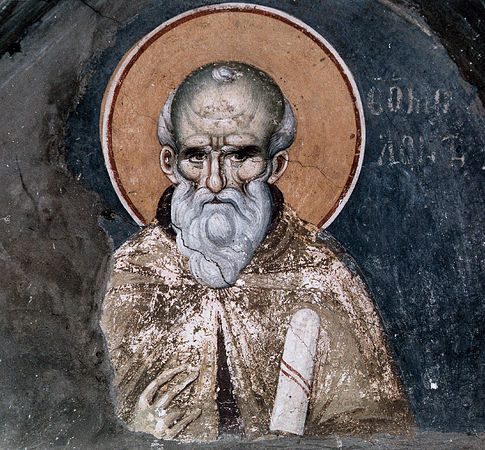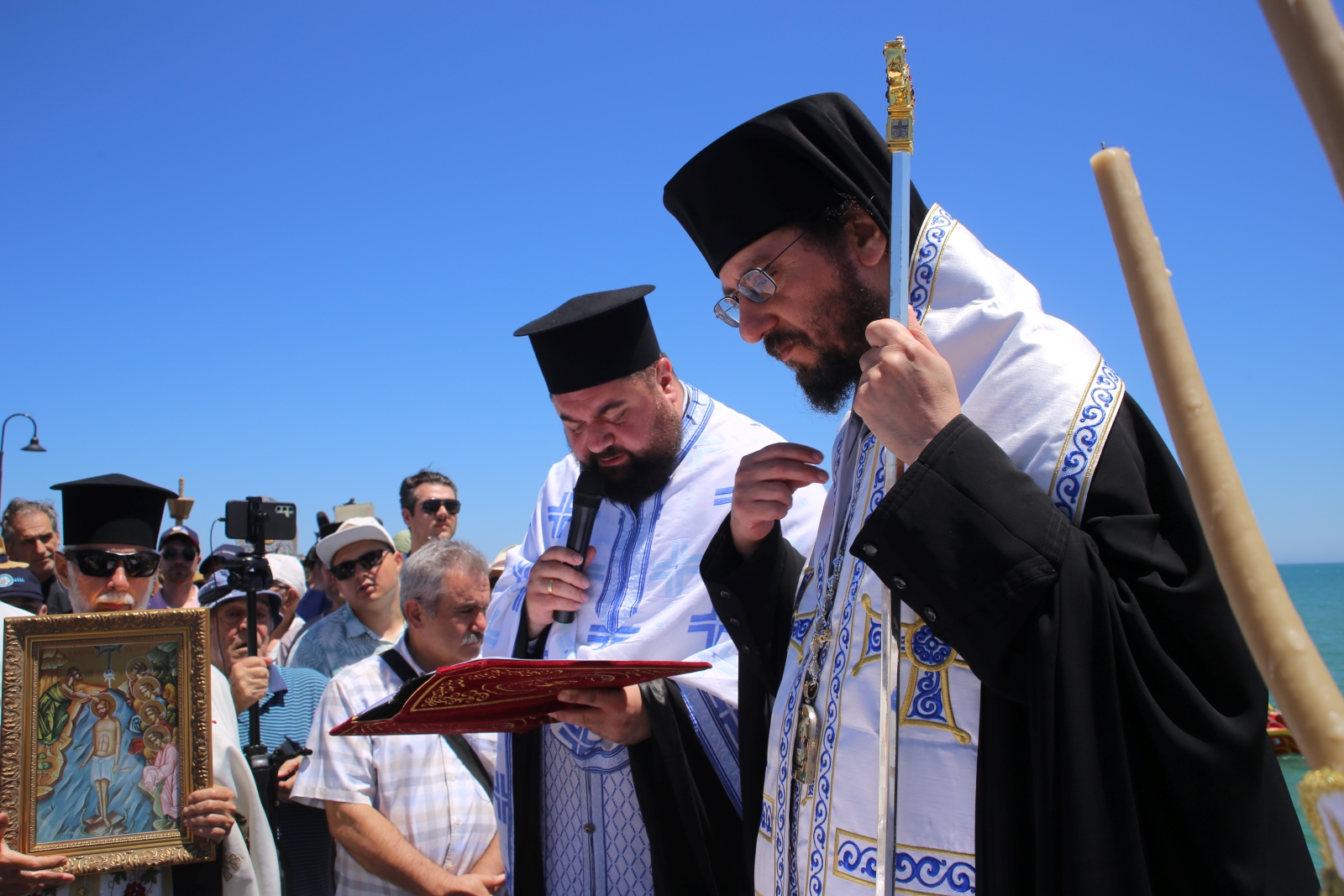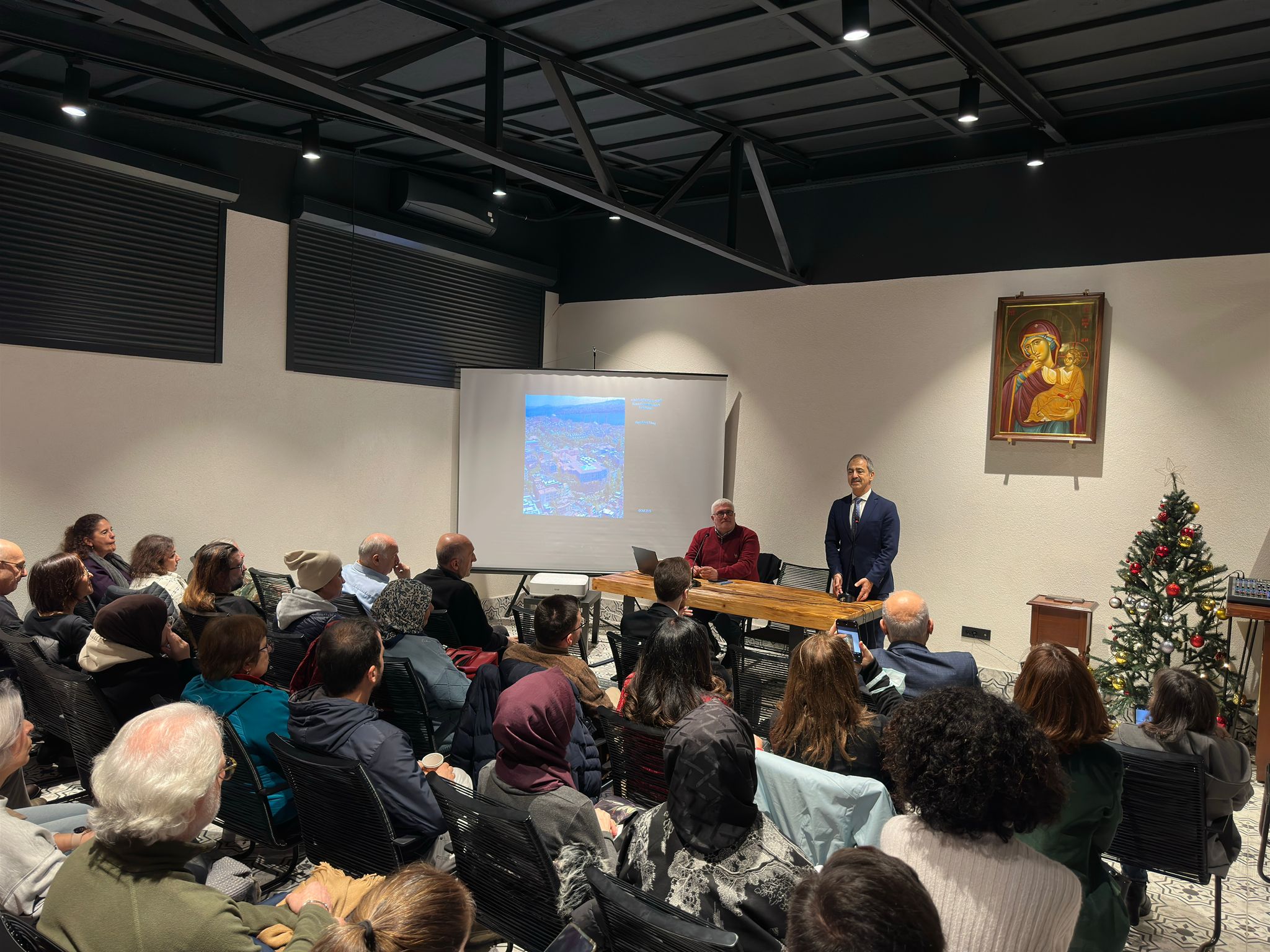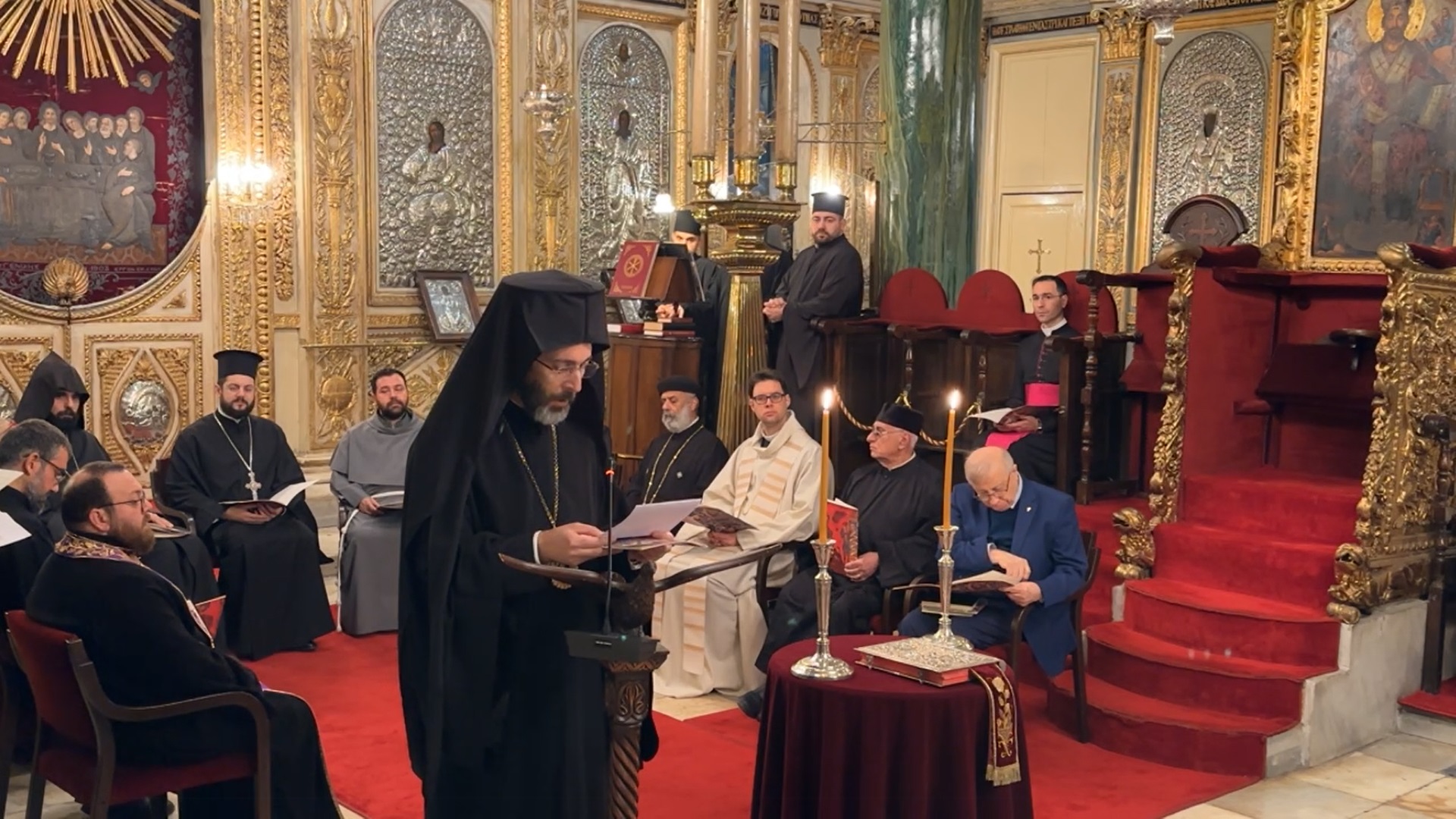Saint Pelagia of Tinos ( 23 July + 1834)
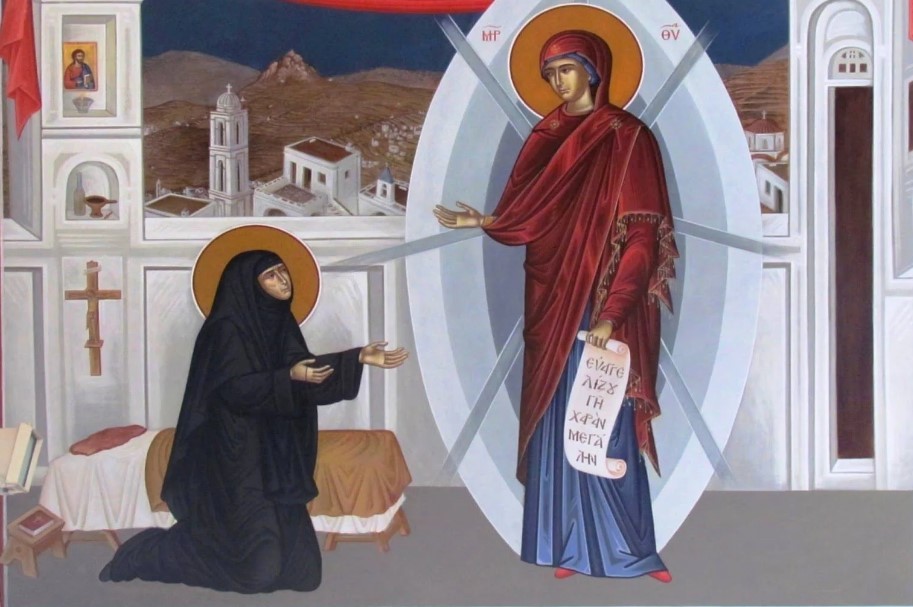

Life of Saint Pelagia
Pelagia was the daughter of the priest Nikephoros Negrepontis. Her mother was from Tripotamos of Tinos and belonged to the family Frangoulis. Born in 1752 in Campo village of Tinos, she was baptized with the name Loukia. From various documents it appears she had three sisters. Her family was distinguished by their pure faith and their adherence to the ideals of the Orthodox way of life.
A few years after Loukia was born her father passed away. She was twelve years old when she began to show signs of longing to devote herself to the service of the Lord. The difficulties of life prompted her mother to send her to Tripotamos to her more affluent sister. Loukia lived there for three years and would often visit her other aunt nearby in Kechrovouniou Monastery where she was a nun. At the age of fifteen she felt it imperative to follow the monastic path, and entered this Monastery as a novice under the supervision of her aunt who was named Pelagia. When the time came she was tonsured a nun and also took the name Pelagia.
As a nun she dedicated her entire self, body and soul, to the worship of God and the relief of the suffering people. The purity of her soul, the holiness of her life, her self-denial and her life of prayer and desire for redemption contributed to the nun Pelagia becoming a “chosen vessel” of the Theotokos, in order to discover her miraculous icon in the field of Doxaras in Tinos on January 30, 1823. This discovery made Tinos a sacred island and helped to rank Pelagia among the saints. The event took place when the venerable one was seventy-three years of age and the Bishop of Tinos was Gabriel.
Through the intercessions of the Panagia and the Grace of God, Saint Pelagia worked many miracles prior to her death and continues to do so today. She reposed in peace on April 28, 1834 and was buried in the Church of the Archangels in the Monastery.
In 1973 a magnificent temple was built in her honor, where her holy skull is kept and venerated today. She was declared a Saint by a Synodal Patriarchal Act on September 11, 1970 with her annual commemoration set for July 23rd, the day of her vision.
The Vision of St. Pelagia and the Discovery of the Icon of Panagia Evangelistria
It was in 1821 when the Panagia sent her first message to a Tinian, named Michalis Polyzonis. She explained to him that her Icon had been buried in the ground under the first church, which had been destroyed in the middle of the tenth century, when Saracen pirates ransacked it and burned it down. She even indicated the precise location, which happened to be on the land of Antonios Doxaras, on the hill above the present town. The Panagia wanted the Icon to be excavated and a church rebuilt above it. She then directed Polyzonis to the place and instructed him to dig.
Polyzonis convinced some friends to go with him to the land of Doxaras, and they dug and they dug, but found only an old Romaic wall. They were disappointed and gave up. Polyzonis continued to talk about the Panagia’s will, but nobody believed him.
At nearly the same time another old man, named Ioannis Guzes from Muntados village, who owned the land next to Doxaras, kept saying that this very area, named “Poles” (which means “towns”), once was a great Venetian principality. The old man was sure that it would be restored in the near future. “There will be thousands of people who will come to this land from all over the world,” he used to say, “who will kneel and bow their heads in awe before it.”
Thus, it happened that two old men, Michalis Polyzonis and Ioannis Guzes prepared the ground for the miracle that was to come from the cell of the nun Pelagia of the Monastery in Kechrovouniou.
THE VISIONS OF NUN PELAGIA
Everything happened according to the the plan that had been written by our Lord Himself. This He did to rejuvenate the belief of people and to show them His love and care.
Therefore, He chose specific people to be the instruments of His Divine Will – Christian examples of modesty, asceticism and obedience.
The prime example has to be the Panagia herself, who gives us the best example of purity, modesty and obedience to the Divine Will. It is because of these qualities that she was so honored by our Lord. In his writings Gregory Palamas says: “God gave the Virgin so much Grace because of her fasting, praying, ascetic way of life and because of the suffering she experienced due to the martyric death of her Son.”
Nun Pelagia always held the Panagia as an example.
THE VISION OF SAINT PELAGIA
Let’s see what the Bishop Gabriel wrote about her in his manuscript:
Pelagia had chosen the way of serving our Lord even in her childhood. She dressed in angelic cloths, fasted strictly and prayed often.
She lived until her seventies, in the Monastery of the Dormition of the Theotokos, in the place named Kechrovouniou. Throughout her life she was honored by the other nuns because of her piety, purity and her capability to see saints. Therefore, she remains in our memory forever, honored by the Church and the people as a saint herself.
There was a vision that came to Pelagia in July of 1822: a woman of power appeared to her who radiated a light which was brighter than the sun, and she spoke to the nun. She wanted Pelagia to speak to the Commissioner of the Monastery of Kechrovouniou, one named Stamatelos Kangadis and to tell him that she wants him to find the site of her church immediately. She told her that this would be found near the town of Tinos on the land of Antonios Doxaras. The instruction was that Kangadis should search for the site and organize the reconstruction of the church, otherwise he would be punished. She wanted this church to be rebuilt magnificently.
Pelagia said nothing. She was afraid that her vision was a work of a demon. She knew of examples where the Angel of Darkness had appeared to humans as an Angel of Light and had led them into error.
The following Sunday the woman appeared to Pelagia again. She insisted the nun inform Kangadis about her will and promised to take care of the expenses of the reconstruction.
“Why do you think that Kangadis will reconstruct your church with such luxury?” the nun asked.
“Because I say so!” That was the answer. “Just do what I’ve ordered you to do and don’t search for the reason.”
That night Pelagia hesitated once again. “Who am I, to help the Lady of the Angels?” she thought. “Why did she choose me?”
Then came the third Sunday.
Once again the vision appeared. This time the Panagia was in a great rage, saying to Pelagia that she would strike her name from the Book of the Living if she would not tell Kangadis about the church and convince him of the necessity of building this church to honor her and to house her icon.
Then it happened. Pelagia asked the vision to name herself.
“Evangelistria, people call me. I announce great joy to the Earth,” was the answer.
Then Pelagia understood who was standing before her. “Glory to the Divine Will of our Lord!” She cried and hurried to the abbess of the nunnery, to tell her all about her visions.
Three times the Panagia came to her: on July 9th, on July 16th and on July 23, 1822.
She explained her hesitation to the abbess with words from the teachings of the holy fathers: “Don’t believe, but don’t deny it also!” She explained that she waited for a sign. The words of the Panagia: “I announce great joy to the Earth” appeared to be this sacred sign. Those words made Pelagia to believe in their reality.
This is an example of how our Lord shows His love. He does not force history like a Judge, He guides humans like a thoughtful father.
St. John writes about it: “The rich God cares for everyone: sometimes He gives orders, some people He threatens, but to chosen ones He sends miracles. However, He always cares for the safety of the human soul. His actions are always full of love and care for humans. Even His rage serves us.”
Chrysostom writes about it: “Our sins are so big that we simply need to fear for our actions. Otherwise, we wouldn’t do anything good at all.”
God is always the same: in His love and in His rage. It can happen that He sends misfortune for a whole nation as a means of helping them to save their souls. Of course, this is difficult for people to understand – sometimes people even deny this testing. There is confusion as to what is good, and what is bad: sometimes people take only the pleasant for the good and see the unpleasant as bad.
THE NUN ANNOUNCES HER VISION
Pelagia told about her visions to three people: Melanfia Paraskeva – the Abbess of the Monastery of the Dormition of the Theotokos, Stamatelos Kangadis – the member of the Committee of the same Monastery, and Bishop Gabriel.
Bishop Gabriel continues:
The abbess of the Monastery, being aware of Pelagia’s loyalty to the Christian ideals, immediately understood that the nun told the truth. She sent Pelagia to Kangadis. Pelagia went to the village Karia, where Stamatelo Kangadis lived, and told him the whole story. He was confused, so he sent her to Bishop Gabriel at the cathedral church of Tinos, which during this time was in Karia. The Bishop listened to the nun carefully. He’d heard of the sacred qualities of Pelagia. He had also known from the history of Christianity that God reveals his Divine Will through visions to pious persons. The Bishop also remembered the story of old Polyzonis. Both of them mentioned the same place where the Holy Icon was buried in the ground.
The Bishop gave his blessing to the chosen nun and ordered an assembly of all the priests, members of local authorities and the general population of Tinos. He told them about the visions of Pelagia and expressed his belief that every person will do everything to search for the Sacred Icon. One problem appeared at once: Doxaras, the owner of the land was back in Constantinople and his field was seeded, for this reason the excavation was postponed until after harvest.
EXCAVATIONS, THE FIRST TRY
From the archives:
“It was September of 1822. The excavations had begun, but the ruins of the church were not found. They decided to dig deeper. After some days the first signs of ruins began to show. A wall 6-12 m. deep and a portico 21 m. deep were revealed. In his notes, Dimitris Mavromaras affirms that there were two churches on the territory: the ancient Church of the Theotokos and the Church of St. John the Forerunner. Both were covered with 3.5 m. of the earth.”
It was decided that these must not be destroyed. Today’s visitors to the west side of today’s complex can see the totally restored Church of St. John the Forerunner.
“The unburied walls of the ancient churches proved Pelagia’s story about her visions. That meant that the church must be restored at once. But the Icon was not found and the work stopped.”
The Bishop wrote with pain: “Ignorance never brought good to people.” The people’s enthusiasm, unfortunately, diminished and the excavation stopped.
THE EPIDEMIC OF CHOLERA
With the discontinuation of excavation, a cholera epidemic struck the population and the guests of Tinos with increasing fatalities. Kangadis’ wife and her sister became ill. Fortunately, however, their disease was not cholera.
This fact made Stamatelo think about Pelagia’s words during her last vision. He went to vespers at the Monastery immediately. He realized that the Panagia had commanded him to work on the reconstruction of her church and he had failed to do so. Because of his disobedience, his relatives and the Tinians were struck by illness. This was the punishment promised by the Panagia.
Usually the illness of the body and the soul appears as the result of sin towards our Lord. Fortunately, God knows everything and reviews everything. In His love towards humans, our Lord cares for the safety of the human soul. Nevertheless, humans also need to cooperate with Him with their own actions. When our Lord offers His precious gift, humans must stretch out their hands and accept it.
God knew that the inhabitants of the island hadn’t accomplished the Panagia’s will and were struck by cholera. He also knew that this terrible illness wasn’t a punishment, but a challenge to strengthen them in the grace of the Panagia. So he saved them from the illness, giving them an opportunity to be delivered from their sins. How this happened we’ll see afterwards, when the Icon will be found.
THE RESUMPTION OF EXCAVATIONS
Kangadis asked Bishop Gabriel to help in resuming the excavations. On November 25, 1822 the Bishop promulgated an appeal to the Tinians:
“I kindly ask all the Christians – the inhabitants of Tinos and the guests of the island – to help reconstruct the church of our Lady and to make her abode the most brilliant and beautiful.”
He also spoke about Kangadis:
“As Stamatelos Kangadis couldn’t afford the difficult work, which was given in his charge, we ask Mr. George Peridis, Antonios Kallergis and Hatzi George Siotis to help Mr. Kangadis in his work.”
Therefore, it happened that four people came to work on the reconstruction of the church. The Bishop blessed them and they resumed excavations. When a boy was sent for some water to be sprinkled by the Bishop, it was noticed with great wonder that an unearthed well suddenly appeared filled with water. With this water, the church was anointed. Then everybody understood that God had blessed their work.
CONSTRUCTION OF THE CHURCH OF THE LIFE-GIVING SPRING
The construction of the Church of Zoodochos Pigi (Life-Giving Spring), according to the archives of the Foundation of the Annunciation, began in October of 1822. Within days ancient walls and the Holy Altar were found and uncovered. The work to rebuild began on November 25, carefully following the parameters of the ancient church.
On January 30, 1823 the building of the church already had a form, which you can see today with three arched halls.
Let’s see what Kangadis wrote about it all in his famous “Kangadis’ Notes”:
“The work in the lower church was nearing completion. The inhabitants of the town and of the villages were building the church, named the Life-Giving Spring. Everybody was sure that the water source must exist. Suddenly one day, when the old well was being cleaned up, water burst forth miraculously. They did not find the Icon nor did they hope to find it there. So the church was rebuilt. Nobody at that time thought about the construction of the upper church, which would shine and become the most gorgeous Church of the Annunciation, as we see it today. But the miracle began here where our human strength and our conscience leaves off.”
You can see the words in the manuscript of the manager are laconic and give us no room for doubt. With these short notes, we have described how the miraculous Icon was found.
DISCOVERY OF THE HOLY ICON
January 30, 1823 was the Feast Day of the Three Hierarchs. Although it was a religious holiday, the work on the church continued. When the earth under the portico of the Life-Giving Spring Church was being broken up, about 2 meters from the spring, at two in the afternoon, the hatchet of one worker struck a piece of wood, dividing it with the blow. The workers picked it up, put the two pieces together, cleaned it, seeing it to be part of the Holy Icon. Of course, it was weathered by time and had been burned on the back.
Once the Icon was cleaned properly, it appeared to show the Archangel Gabriel holding out a lily to the Virgin Mary, the so-called Evangelismos or Annunciation (after which it is named “Evangelistria”). In spite of all the years that had passed and the fire that burned it, the images were not vanished completely. One piece showing the Archangel and the second one the kneeled Virgin accepting the Divine Message of Incarnation of the Savior could be seen clearly.
People understood that they finally had found the Holy Icon. They knelt before it, then gave it to Bishop Gabriel. News of the discovery of the Holy Icon spread with lightening speed though the town of Tinos and the surrounding villages. Masses of people assembled from all directions to pay homage to the Icon, hoping that now the cholera epidemic would end.
Their hope was not in vain: The miracle happened and people were cured. Among those cured was Peridis’ son. Only some days before, the first signs of the awful disease had appeared on the young man. To escape the illness his parents were obliged to leave their home and place their son into the hands of nurses.
Now, when the Holy Icon was discovered, Peridis knelt before it, pleading for his son’s recovery. Then he took some earth that was still covering the Icon, added some holy water and asked the nurses to rub his son with it. So this was done.
In the morning, trembling with fear, he went towards his house to find the news about the health of his son. All of a sudden, he saw his son coming towards him, completely cured. The overjoyed father went immediately to thank the Theotokos.
CONSTRUCTION OF THE CHURCH OF EVANGELISTRIA (ANNUNCIATION)
Immediately after the discovery of the Holy Icon, a decision was made to reconstruct the whole church, the foundations of which had now been totally excavated from the ground. Very soon, the new building began to rise up. Its length was 19.5 meters and its width 12.1 meters. Such a big building needed more hands and more money. Meanwhile, the stream of pilgrims was growing. Not one pilgrim went away without help from the Holy Virgin. Therefore, the Theotokos kept her promise as money was gathered from the pilgrims for the building of her church. As many miracles happened, more people wished to ask for help from the Holy Icon.
The church is the real miracle. It astonishes us by the luxury of the interior and by the marvelous work of the wooden details. One can be inspired by the work accomplished by our forbearers within such a short time. It is also amazing how carefully the church has been preserved to our days and continues to give joy to all those who wish to touch this miracle.
Apolytikion in the Fourth Tone
Blamelessly you lived with much self-control and ascetic labor and fervent love, God-possessed Pelagia. Wherefore again and again you saw the Theotokos, disclosing to you the discovery of her icon. Therefore intercede, Venerable Mother, on behalf of those who honor you.






